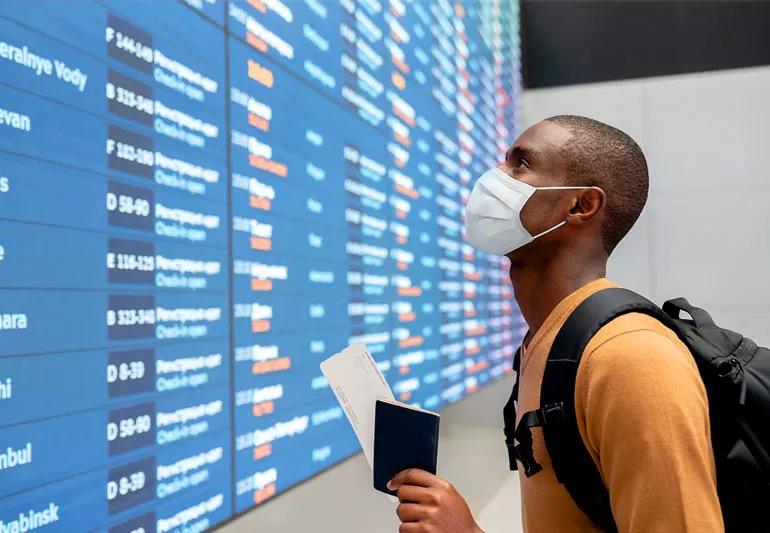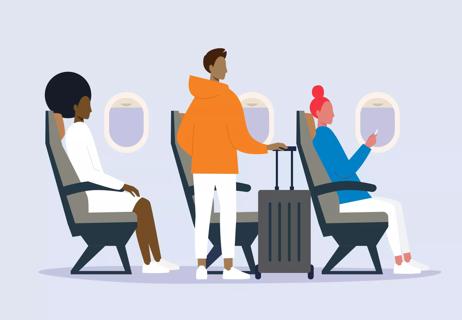Protect yourself whether you're on a plane, ship or in a car

Traveling right now might require a more detailed and cautious approach, but it can still be done while minimizing the risks of being exposed to variants of COVID-19. We spoke with pulmonary and critical care physician Joseph Khabbaza, MD, about the subject. Keep reading to find out what he has to say and get some tips for staying safe whether you’re in the car, on a plane, at a hotel or on a cruise ship.
Advertisement
Cleveland Clinic is a non-profit academic medical center. Advertising on our site helps support our mission. We do not endorse non-Cleveland Clinic products or services. Policy
As you’re planning your trip, it’s good to be mindful of every possible scenario you could encounter. By taking a proactive approach, you can help keep yourself and those traveling with you safe.
Here are a few questions from the U.S. Centers for Disease Control and Prevention (CDC) to consider as you’re creating your itinerary.
“Because of the significantly higher levels of immunity to COVID-19 both from vaccination and infection, as well as significantly lower case numbers, we’re in a much different place than we were a year ago,” says Dr. Khabbaza. “The standard advice for staying safe remains the same but there’s still a strong emphasis on your immunity status, your personal risk factors and any vulnerable people in your life that you might be around after you travel.”
Advertisement
According to the CDC, you should skip your trip for the following reasons:
Considering our vehicles are familiar and comfortable to us, it makes sense to embrace the road warrior approach for vacation. But in order to avoid riding in style with germs, there are some precautions you should take before you hit the road.
Start by cleaning and disinfecting your vehicle thoroughly. Wipe down all high-touch surfaces and parts (windows, seat belts, the steering wheel, door handles, controls, etc.). And be sure to keep antibacterial wipes and hand sanitizer in the car so you can wipe down everything and passengers can clean their hands after each stop.
When it comes to passengers, limit the number of people in your vehicle if possible. And since can’t all be six feet apart, it doesn’t hurt to wear masks in the car, especially if you’re traveling with someone who’s at high risk for COVID-19 or someone who isn’t in your immediate circle.
Before stopping for gas or food, designate a runner for travel-related tasks. Have one or two people who aren’t at high risk go in to grab snacks or buy gas if you don’t want to pay at the pump. Just make sure your designated runners mask up and clean their hands thoroughly before getting back in the car.
Ride-share services have made it much easier for us to get around whether we’re at home or out of town. Before you hop into a ride-share vehicle, make sure you have hand sanitizer with you to use once you arrive at your destination. Also, don’t accept complimentary drinks, magazines, candy or anything else that is offered to riders.
“When getting in a ride-share vehicle, it’s important that both you and the driver wear masks, especially since you’re in a small space with a stranger for a good amount of time,” Dr. Khabbaza says. “You can even wear eye protection in this setting to minimize the risk of infection or transmission.”
Advertisement
The carpool option with ride-share apps might allow you to save big during certain times of the day, but right now, it’s not worth it given the increased risk that comes with being in close proximity to a stranger.
So, keep rides limited to you and the people you’re traveling with. And when possible, ride in the back seat instead of the passenger’s seat to keep a little distance between you and the driver.
Dr. Khabbaza points out that some ride-share drivers have added a partition between the front and back in their vehicles. This minimizes the risk of transmission significantly. He suggests doing a little research on each ride-share company beforehand so you’ll have a better idea of the safety features that are available in the area.
If you decide to take to the skies, keep in mind that staying safe on a plane requires far more than just wearing a mask. Before you even get to the plane, you have to contend with check-in terminals and security lines. This means coming in contact with frequently touched surfaces and being around a lot of people. So masks, social distancing and hand hygiene are still very relevant for that extra layer of protection.
As of January 21, 2021, it is a violation of federal law not to wear masks on public transportation according to the CDC guidelines. So, any commercial airline you fly should require all passengers to wear a face mask. This includes children age 2 and older.
Advertisement
Ultimately, it’s up to you. Just keep the risks in mind when making the decision. If you’re sick or at higher risk for COVID-19, it is probably best to stay on the ground. The same goes for any friends or family members who want to travel with you. “The decision on whether you should fly depends on your personal level of risk tolerance and being aware of the local rates of COVID-19 at both your starting and final destinations,” says Dr. Khabbaza. “If you do choose to fly, it can be done safely by sticking to the basics.”
It’s inevitable that if you head out of town, you’re going to need a place to rest your head. Some might opt for a hotel, while the privacy of a vacation rental home might appeal to others. Either can be safe if you’re cautious, follow social distancing guidelines and ask the right questions beforehand.
Before booking, look into the hotel’s or rental property’s cleaning protocol. In an effort to maintain transparency, a lot of places are disclosing how they’re going above and beyond to keep guests safe. For instance, hotels are disinfecting more and offering online check-in and digital keys. Many have also implemented 24-hour vacancies for rooms in between guests.
The CDC says that cruise ship travel isn’t a zero-risk activity. The chances of contracting COVID-19 are fairly moderate even if you’re vaccinated.
Advertisement
Here are their recommendations if you plan to go on a cruise:
If you’ve recovered from COVID-19 within the last 90 days, you aren’t sick at the time you plan to travel and you aren’t considered a “travel don’t” based on the CDC’s recommendations, you’re free to go. The CDC says you don’t have to get tested before or after your trip, but should you develop symptoms before, during or after it, you’ll need to isolate and talk to your healthcare provider about testing.
As for other requirements, be sure to check with transportation providers (airlines, cruise ships, etc.) to see what is needed.
Whether you’re vaccinated or not, you’ll need to look out for symptoms and isolate if you do start to experience them. However, if you’re not up-to-date with your vaccination doses, the CDC recommends taking a viral test three to five days after you return from your trip. They also suggest a self-quarantine for five entire days after travel.
Learn more about our editorial process.
Advertisement

Flying can cause dehydration and bloating and make you feel tired and stressed

How to pack a well-stocked travel emergency kit

Booked plane tickets? Here’s 8 travel truths

The short answer: It’s complicated, but the basic care precautions still prevail, like washing your hands and isolating if you’re sick

They can feel like a typical headache or a migraine headache, but the pain can last for weeks to months

Any large social gathering — from a family birthday party to an indoor music concert — has the potential to spread serious infection

It’s important to connect with a healthcare provider, get quality sleep and balance your activities with your energy levels

Symptoms can overlap and be hard to distinguish, but there are some telltale differences

Type 2 diabetes isn’t inevitable with these dietary changes

Applying a hot or cold compress can help with pain